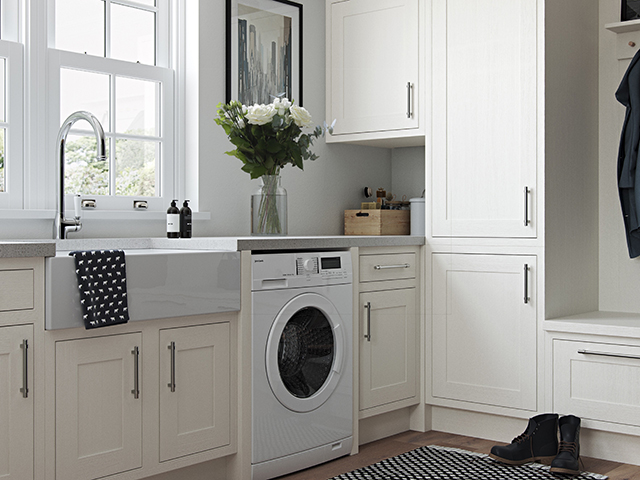Utility room safety advice
Make safety a priority when appliances, electrical fittings and water are in the same space
Utility room safety is a priority when appliances, electrical fittings and water occupy the same space. This guide will help you design a safe space.
There are many benefits to having a room or area for doing the laundry or keeping foodstuffs separate from the kitchen. Everything is close at hand and easy to organise. Any clutter is out of sight of the kitchen and dirty laundry is kept away from cooking ingredients.
But careful thought and planning is needed to reduce the risk of accidents. Choose the right flooring, follow the rules on electrical safety and design a workable layout.

Linear units in Little Greene’s Confetti, from Harvey Jones
Floor safety
Non-slip flooring is a must for utility room safety. Always look for surface finishes suitable for use in areas that may get wet. So, look for durable engineered timber and non-slip tumbled or riven stone finishes. Also, large-format porcelain tiles, with a textures surface, have fewer grout lines making them easier to clean. And textured luxury vinyl or linoleum is soft underfoot and a breeze to wipe over.

Kahrs Oak Chevron Light Grey engineered wood flooring from Carpetright
Layout matters
Design the layout to minimise the risk of open doors and drawers causing an obstruction. This avoids the danger of walking into something causing you to fall or drop what you’re carrying. For instance, in a U-shaped layout plan for at least a metre between units.

Bespoke kitchen with walk-in pantry and metal-framed glass partition from Blakes London
Electrical regulations
Certain electrical work has to be notified to the local building control department to meet safety standards. So, seek advice from your kitchen fitter or electrician. A National Inspection Council for Electrical Installation Contracting (NICEIC) contractor is able to self-certify the work. If necessary, they will notify the local building control department.

English Revivial Shaker utility room from Mereway
Laundry basics
Allow around a metre of free space in front of washing and drying machines for loading and unloading safely. So, consider putting the drier on top of the washing machine in a small room. To do so, invest in the machine manufacturer’s stacking kit for utility room safety.
Avoid cross contamination
It is important to keep dirty laundry separate from stored foods and the cooking area. One way to do this is to invest in a built-in laundry chutes, which delivers clothes directly to the utility area. Specialist companies offer full installation and DIY kits are available for retrofitting. This laundry chute leads from the bedroom above, project by William Green Architects. The hand painted cabinets and work surfaces are from Hush Kitchens.

Hand painted cabinets and worksurfaces by Hush Kitchens
Easy access
Fitting a sliding or pocket door at the entrance to the room saves a lot of floorspace in a small room. Or when creating a separate area off the kitchen. Good lighting is crucial for carrying out tasks safely and having a glazed door will bring light into a windowless space. Another idea is to install recessed ceiling spotlights that come on automatically whenever the door is opened.

Bespoke Manhattan kitchen with quartz work surfaces and walk-in pantry, Mowlem & Co
Food hygiene
Keep foodstuffs fresh and free from mould by storing them in a cool, dry place. Unless you have an air conditioning system, site a pantry on a well-ventilated external north- or east-facing wall within easy reach of the kitchen. Plus, reach high shelves safely by investing in a sturdy step-ladder.

Longford Pantry with Caesarstone worksurfaces and oak mini ladder, Humphrey Munson
Safety first
Expert advice from Max de Rosee and Claire Sa, directors of architectural practice De Rosee Sa
- Unless a property is listed, permitted development (PD) allows you to make internal alterations to your home without planning permission. But you will still need to comply with Building Regulations for any structural, electrical and drainage works. So, for more information, visit the Planning Portal.
- Good air circulation is vital and also a regulatory requirement for a new utility room. Consider fitting mechanical ventilation with heat recovery (MVHR) as part of a whole house renovation. It provides fresh, filtered air in every room. Otherwise, an externally vented extractor fan will help prevent damp or mould. Installing airbricks and trickle vents also decreases the chance of these issues arising.
- If external ventilation is not an option, an electronic dehumidifier extracts excess moisture from the air. Opting for a condenser dryer can also help, as it does not require venting.
- For safety, electrical sockets should be installed at a minimum distance of 300mm from a sink or drainer. So, they must not be directly under a sink or near pipework.
- It is worth considering installing a gully in laundry areas. This drain in the floor provides a route out for water from a leaking machine and avoids costly repairs.
- If you plan to have a boiler or cylinder in the utility room, make sure that there is adequate space around it for maintenance. Always install a carbon monoxide detector for peace of mind.
- Utility and laundry rooms can be noisy. Opt for appliances that carry Quiet Mark accreditation. They will have the lowest decibel rating and run quietly.



